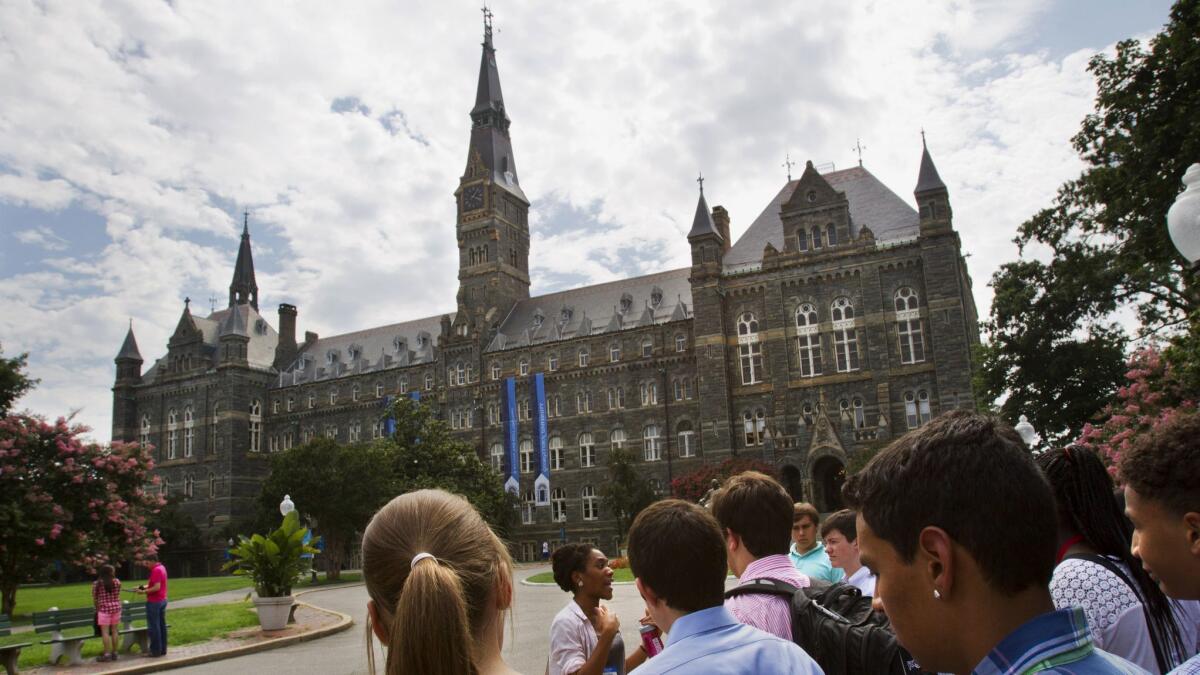News Analysis: Students are borrowing less. So why do they owe more?

- Share via
Few things move in a perfectly linear line in finance or in the world in general. Markets and economies rise and recede. Demographic trends shift over time. Life itself is full of twists and turns.
The growth in U.S. student-loan debt, on the other hand, has been entirely predictable for the last 17 years, rising to $1.5 trillion.
This trend, of course, has fueled a national debate about student loans and is why Democratic candidates for president such as Massachusetts Sen. Elizabeth Warren and Vermont Sen. Bernie Sanders have made college-debt forgiveness a pillar of their economic platforms.
The costs of young Americans saddled with onerous debt burdens are well-chronicled: declining homeownership rates, dwindling small business creation, delays in marrying and having children.
This is not the whole picture, however. Even though the growth looks perfectly linear, the reason for it began to change almost a decade ago.
The amount of new student-loan borrowing has declined 8% since peaking at $115 billion in 2012, including a sharp 24% reduction among undergraduate students, Moody’s Investors Service said in a recent report.
From 2010 to 2018, the undergraduate population fell by more than 1 million, according to the credit rater, for mostly good reasons. Community college enrollment is down because the U.S. economy is strong, while for-profit institutions have come under closer scrutiny. Those who do still borrow, Moody’s says, have “greater potential for increased earnings.”
What, then, explains the ever-higher debt load? Simple: Borrowers aren’t repaying what they owe. Or, at least, not nearly with the expected urgency.
Any way you slice the data, this trend is staggering.
Consider borrowers who were in school during the financial crisis (repayment obligations that started in 2010-12). About half of them made no progress in reducing their balance after five years, according to Moody’s.
That aligns with a Federal Reserve Bank of New York report in October, which found a mere 36% of borrowers who were current in their loans in the second quarter made a dent in their balance over the previous year. Overall, during the last decade, the existing balance eliminated each year has averaged just 3%.
That’s obviously a tiny percentage, lower than the current fixed interest rates on federal loans of 4.53% for undergraduates and 6.08% for those attending graduate school. So borrowers as a whole aren’t even treading water.
That’s not the end of the story, though. Because part of the reason the repayment rate is so low is intentional.
Many college graduates are using income-driven repayment options, which grew in popularity after the financial crisis as a way to help people manage their student-loan debt. In general, they cap required monthly payments based on a percentage of discretionary income, a boon for those who don’t have high-paying jobs.
Four of the five programs cited by Moody’s include outright debt forgiveness after 20 to 25 years of qualified payments.
The trend “is materially suppressing repayment rates, in part because many borrowers’ IDR payments fall below monthly interest accruals, resulting in growing loan balances even as borrowers make required payments.” More than half of the balances of borrowers who owe more than $200,000 are in income-driven repayment programs, while only 5% of those who owe less than $5,000 are covered by income-driven repayment, Moody’s said.
The fact that borrowers — and especially those who owe six figures — can pay less than the interest rate on their loans, in turn, directly impacts holders of student-loan asset backed securities, a constituency of Moody’s. The Wall Street Journal published an article earlier this month about this very issue, with the headline: “A Borrower Will Be 114 When Bonds Backed by Her Student Loans Mature.”
The whole thing is a bit of a mess.
To summarize, the article starts with Julie Chinnock, a 50-year-old who owed about $250,000 in student loans. She entered into an income-driven repayment program, like her peers, and bonds backed in part by her payments were on the verge of a downgrade by Moody’s, which in 2015 altered its methodology to factor in slower repayments.
The issuer of the asset-backed securities and the investors who owned them agreed to extend the maturity dates by decades to keep their top ratings. The Consumer Financial Protection Bureau has become involved in recent years, concerned that issuers of “SLABS” might mislead student-loan borrowers because of their incentive to prop up credit ratings.
All of this is to say, the student-loan crisis is far more intricate than an upward sloping, seemingly unstoppable linear line. The aggregate figure is staggering, to be sure, especially considering what it was just a decade ago. And it’s troubling that a wide swath of the U.S. population can’t dig out from under its debt load.
But consider the following:
• The inflation-adjusted cost of obtaining an undergraduate degree is now mostly holding steady relative to household income. So while it’s true that higher education costs skyrocketed over the past few decades, the same doesn’t quite hold up when focusing on recent years.
• As previously mentioned, fewer young Americans are heading to for-profit and two-year institutions, where it might be tougher to land a job that pays enough to wipe out student loans.
• To top it off, many borrowers are intentionally slowing down their repayment speed, often to the point that their outstanding balance grows even after making qualifying payments.
Taken together, it’s hard to make the case that the proliferation of student loans is getting appreciably worse.
Rather, the debt appears to be predominantly a burden of those who went to school during the period in which college prices were rising sharply relative to inflation and when the lingering economic consequences of student loans were less well-known. With those borrowers now nearing their prime earning years, it’s little wonder why debt-forgiveness plans are alluring public-policy proposals.
Chappatta writes for Bloomberg.
More to Read
Inside the business of entertainment
The Wide Shot brings you news, analysis and insights on everything from streaming wars to production — and what it all means for the future.
You may occasionally receive promotional content from the Los Angeles Times.










